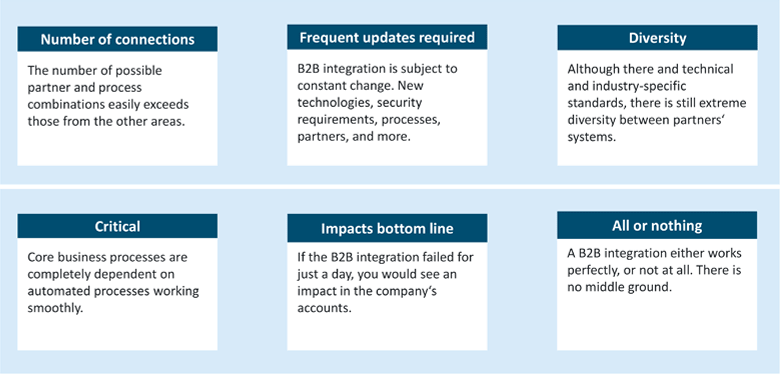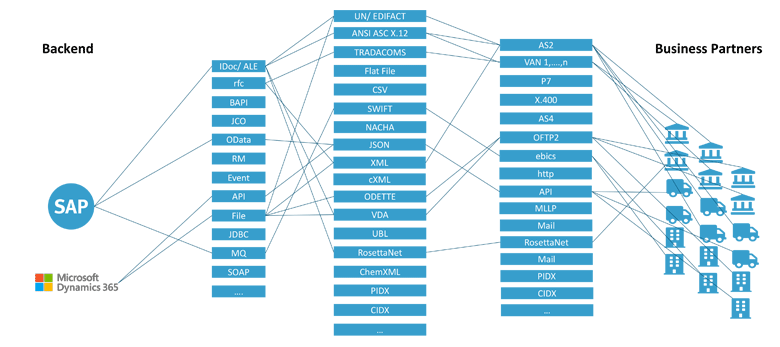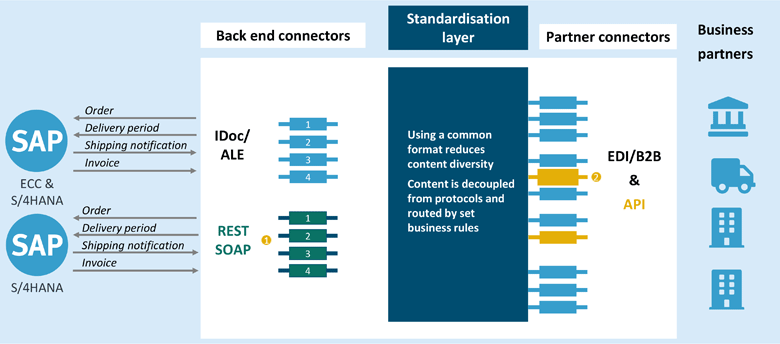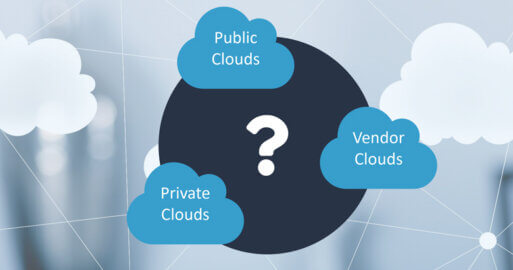Integrating SAP S/4HANA for B2B – How Content and Common Formats Can Help

When introducing or migrating to SAP S/4HANA, B2B integration is a challenge. There are several different interface technologies in use, including APIs. Your systems and data always need to comply with certain laws. And your connected external partners will have certain requirements, too. This article looks at the advantages of using content and common/canonical formats, and how the ability to decouple connections ensures high-level standardization of your migration processes.
The challenges of integrating SAP S/4HANA for B2B
Of the four main integration areas in migrating to SAP S/4HANA, B2B integration is particularly challenging. We have already looked at 6 reasons why. These are summarised below:


In-house integration teams, particularly those who need to connect external business partners and government agencies, have a few questions to answer:
- What interface technologies does SAP S/4HANA support? And which of these options is the best for our needs now, and in the future?
Should we stick to the established technologies S/4HANA still supports? Or are the new options more future-proof? What do we do if an interface is no longer supported? Could we switch over if we’ve made the wrong decision? - How can we ensure we’re complying with all the e-invoicing legislation?
How much work is it to implement the differing legislation for international subsidiaries or business partners using e-invoicing? - Will APIs continue to replace asynchronous, batch-orientated approaches in B2B integration?
- What does it mean for us when important business partners start using APIs for their B2B processes?
- To what extent do the underlying processes stay the same?
- Where will we see a change in processes? (e.g. a move from push to pull processes)
- What do APIs mean for our IT security?
- How do integration teams scale when on-boarding business partners for automated business processes when migrating to SAP S/4HANA?
B2B integration is the most complex of the four areas covered in this series. It has the highest range of technologies and data formats to support as well as business semantics. It requires testing with external partners, which is difficult to organise. This dependency on outside organisations and systems make it extremely difficult for an integration team to fully complete and test their work on time. This is a particularly pertinent issue given the short time available to migrate to SAP S/4HANA.
The solution for migrating to S/4HANA: a common format layer
An elegant way to address all these issues is to employ a highly standardised concept and procedure. This involves decoupling partner content and specific B2B technologies from SAP content and selected SAP interface technologies.

In order to be able to decouple elements, you need to employ a common format as an intermediary layer.
Transforming your partners’ individual technology and format requirements to these generic processes makes them far simpler to map to the relevant backend systems. And this makes complex B2B integration requirements far easier to manage and maintain.
When a new partner is added, it is their content being added, not their systems. And this means that they no longer need their own integration project. Furthermore, you could choose a provider who also maintains this content. And this reduces all the potentially complex work on your side to a content update.

Conscious uncoupling – this is how you reduce your workload when migrating to S/4HANA
Figure 4 shows how decoupling might work for an organisation actively using SAP ECC while simultaneously rolling out S/4HANA. Looking at the ERPs in the back end, you can see that it doesn’t matter which SAP integration technology they use – legacy or the new options. This gives you the option of continuing to use SAP IDoc/ALE interfaces when SAP S/4HANA goes live. Assuming, of course, there are enough IDocs and that they have been adjusted as necessary.
The beauty of this is that if you later choose to use the modern interfaces, it doesn’t involve much work. (cf. figure 4: *1). You can continue to use your huge range of partner content and will only need to map a few processes.
Using a common format as an intermediary layer makes migrating to SAP S/4HANA quicker and easier.
As you are drawing just content, using a common format as an intermediary layer works regardless of the actual integration technologies and content formats your partners use. Example *2 in figure 4 shows an external partner using APIs instead of the classic EDI technologies to exchange business documents. It is scalable, and future-proof, as you can continue to use it if new technologies are introduced. And that means your investment has been worth it.
Find out more about how SEEBURGER can help you integrate SAP S/4HANA, and have a look at our blog posts covering the things you need to consider in this mammoth task. For one thing’s for sure: S/4HANA integration is best left to the experts.
Thank you for your message
We appreciate your interest in SEEBURGER
Get in contact with us:
Please enter details about your project in the message section so we can direct your inquiry to the right consultant.
Written by: Thomas Kamper
Thomas Kamper, SVP Strategic Product Management, is responsible for strategic product initiatives related to all SEEBURGER’s business integration technology and solutions. The focus is currently on API solutions and Big Data. In addition, he is responsible for solutions that enable organizations to master challenges of visibility and to control the proper execution of digitalized business processes. Thomas rejoined SEEBURGER December 2017. Before, he worked for many years as a hands-on interim manager and business advisor supporting C-level executives within software and cloud service providers to make their strategic product initiatives successful.





